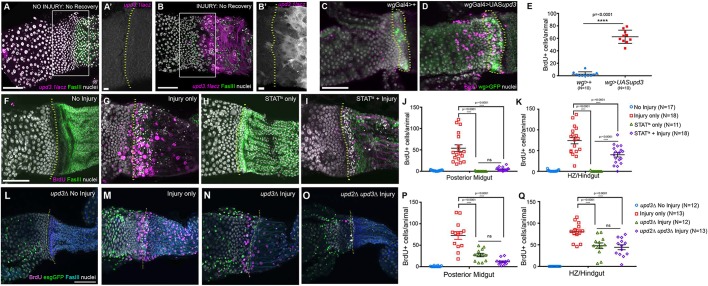Fig. 6.
OB-ISCs respond to injury-induced Upd3. (A-B′) upd3 is induced after injury. upd3 is rarely observed in the absence of injury (A,A′), but is strongly induced after injury (B,B′). (C,D) Ectopic upd3 expression, with wgGal4, drives cells in the HZ and midgut cells to re-enter the cell cycle. (E) The number of BrdU+ cells in the HZ and midgut after injury is significantly higher with upd3 expression than without upd3 expression. Data represent mean±s.e.m. Unpaired, two-tailed t-test, unequal variance. (F-K) Knockdown of Stat92E. (F-I) Blocking Stat92E function results in a reduction of injury-dependent BrdU incorporation, primarily in the posterior midgut. (J) BrdU incorporation in the posterior midgut. Data represent mean±s.e.m. (K) BrdU incorporation in the HZ/hindgut. Data represent mean±s.e.m. (L-Q) Knockdown of upd3 and upd2/3. (L-O) Blocking Upd signaling results in a reduction of injury-dependent BrdU incorporation, primarily in the posterior midgut. (P) BrdU incorporation in the posterior midgut. Data represent mean±s.e.m. (Q) BrdU incorporation in the HZ/hindgut. Data represent mean±s.e.m. For J-K, P and Q, a one-way ANOVA with Tukey's multiple comparisons test was used. Genotypes and markers are indicated within panels; yellow dotted lines indicate the HZ. Scale bars: 50 µm in A,B,C,F and L; 10 µm in A′ and B′.

